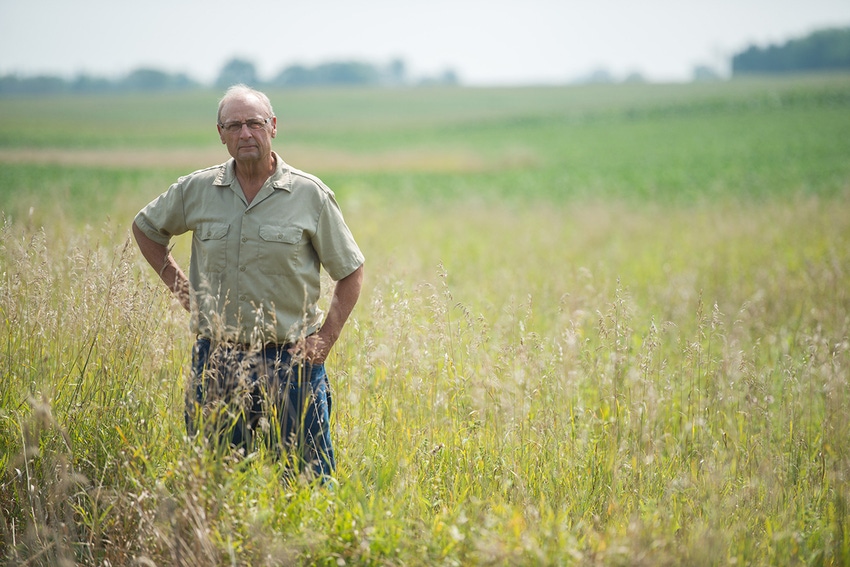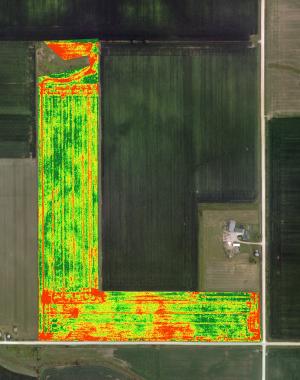
Think DifferentA profit/loss field map caused Fredricks to think different about every area within every field. Software analysis shows that 3% to 15% of most fields are not consistently profitable.“Money is what got my attention, but this also gives me an opportunity to put in improved buffer strips to improve environmental protection,” Fredricks says.“There were five acres where we were losing an average of $280/acre each year,” says Greg Deim of Ag Guidance Consulting.
August 20, 2015

Five fields on Wayne Fredericks’ farm took on a new look this year after he decided to retire small parcels in each of them to boost profitability and improve the environment. Although the retired areas are small – the largest is 3.2 acres and the smallest just under 3/4 of an acre – Fredericks says it makes sense to quit growing crops in these areas that lose money every year.
Fredericks made the decision after having his farms analyzed for profitability on a sub-field level.
“When the three-year average was in the red through some pretty good years price-wise, you know you have an opportunity to increase your bottom-line profit by taking them out of production,” says Fredericks, who farms near Osage, Iowa.
One of those aha moments
Fredericks says his eyes were opened after using a new on-line software program called Profit Zone Manager (PZM). Developed by Iowa-based AgSolver Inc., PZM analyzes profitability in 3-meter quadrants based on multi-year yield data, as-applied fertilizer and as-planted seeding rates, along with actual production costs.
“I could have come up with the same results by analyzing yield maps,” says Fredericks, president-elect of the Iowa Soybean Association. “But all of a sudden, when you are looking at a dollars-and-cents map, it spurs a different thought process. You begin asking, what’s a quick thing I can do to fix that.”
In the five areas that Fredericks took out of production, he concluded there wasn’t much he could do to rectify low yields. Meanwhile, he continues to examine other underperforming areas such as fertility and drainage issues to hopefully boost their financial performance.
“What we see many times is that a farmer already knows that yields are low, but when we provide high-resolution data that puts yield in the context of business financial performance, it changes their thinking,” says Dave Muth of AgSolver.
PZM analysis shows many fields across the Corn Belt have small pockets that consistently lose money. Some of these areas can be addressed through improved management or physical changes, such as drainage. But others can’t.
Retire 3% to 15% of most fields

Click for larger image.
“From what we have seen, between 3% and 15% of most fields is consistently not profitable,” says Muth. Other parts of fields probably should be put on a strict input diet, since their productivity tends to be capped by soils and other limitations.
The parcels Fredericks retired range from a 3.2-acre piece surrounding a sinkhole, to smaller .7 to 1.2-acre areas along building sites, windbreaks and a waterway. “In all but one case, yield was at least 20% below the farm average, and all consistently lost me money,” he says.
Several were environmentally sensitive, including the sinkhole and waterway parcels. “Money is what got my attention, but this also gives me an opportunity to put in improved buffer strips to improve environmental protection,” he says. “It is going to improve the bottom line economically. It is going to improve water quality and wildlife habitat. This is a win-win for me.”
Depending on the field, Fredericks planted retired areas in a filter strip and wildlife habitat/pollinator habitat mix, chosen with assistance from Pheasants Forever.
In addition to avoiding red ink by not planting annual crops, Fredericks also was able to enroll all five parcels in the Conservation Reserve Program (CRP). Rates were high enough to at least cover rent to landlords on parcels that are rented.
Environmental implications
Many unprofitable areas are environmentally sensitive, so retiring them could enhance environmental protection while improving profits, notes Muth.
That possibility has conservationist Dave White, former chief of the USDA Natural Resources Conservation Service (NRCS), excited. “The question we have been asking is how do we maximize production to meet future food needs and at the same time protect our natural resources,” he says. “This approach could be a win-win for improving productivity and the environment.”
More land retirements ahead
While Fredericks worked directly with AgSolver to identify no-profit acres, in the future the company plans to work with crop consultants and others to offer PZM services. PZM is expected to cost $2-$2.50/acre.
Greg Deim of Ag Guidance Consulting, LLC in Swea City, Iowa, already has begun talking with clients about using PZM on their farms. He’s using sample fields from his family’s farm, along with Iowa State University crop budgets, to illustrate the possibilities.
Using PZM to analyze nine years of yields, one of his family’s fields showed an average return on investment of 12.7 percent. “But there were five acres where we were losing an average of $280/acre each year,” he says.
PZM is quick. “Within about five minutes I can get a profitability picture of a farm,” he says. “This allows you to run multiple scenarios and make some hard decisions easier. It also helps quantify acres that are historically profitable and allows a grower to ask why, and can it be even more profitable?”
You May Also Like



